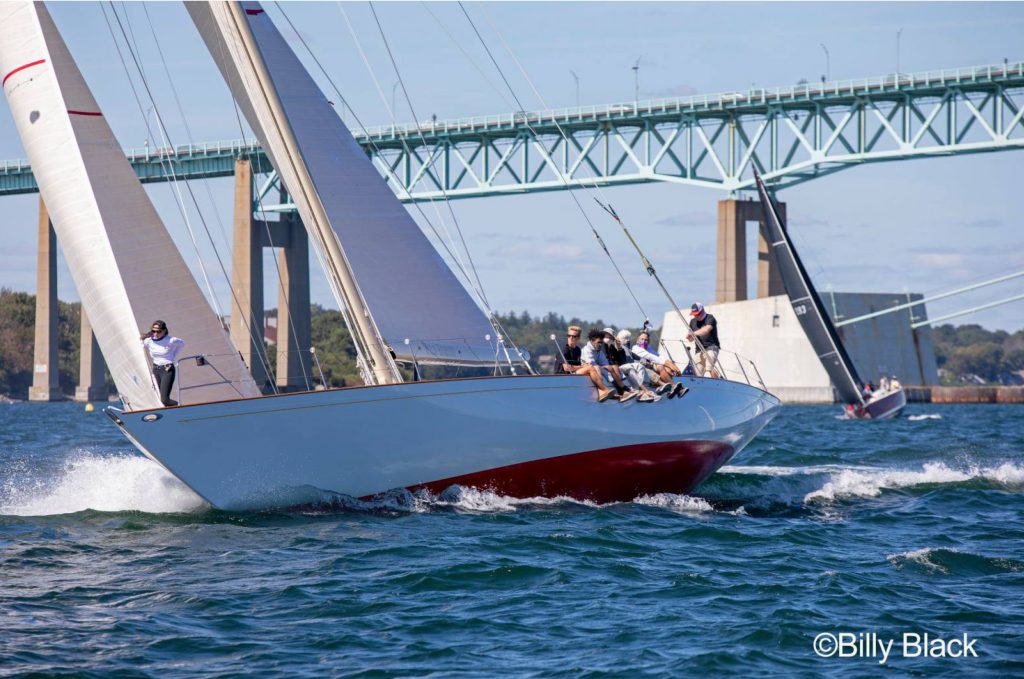Most sports require a certain amount of thinking ahead. If you’re racing a Formula 1 car, for example, you wouldn’t want to come out of a curve and wonder which way the track will turn next. When you’re skiing a slalom race, you always need to know where the next few gates are so you can set up properly for each turn.
The same is true with sailing. The more you are able to anticipate the future, the better off you’ll be. This is especially helpful when it comes to tactics. Of course, it’s hard to predict exactly what other boats will do, but most of the time you can make a good guess. Here are a few things you should do, while racing upwind, to get ready for upcoming tactical situations.

One of the most important prerequisites for anticipating your next move is keeping a good lookout. This is a job that should be shared by as many of your crew as possible. © Billy Black
Maintain a good lookout
It’s important to look at your sails and watch the wind that’s coming on the water, but you also have to keep your head out of the boat to see what’s happening with your competitors. For example, are there any boats affecting your clear air? Are any boats converging with you? If any of the boats that are nearby suddenly tacked, how would they affect you?
In order to execute good tactical moves, you need as much time for planning as possible. Sometimes you may have only a few seconds to respond to another boat’s move, but every second counts. If you aren’t keeping a good lookout, other boats will catch you by surprise. Your tactics will be reactive instead of proactive, and you’ll have to make decisions on the fly. To avoid this, ask everyone in your crew to keep their heads out of the boat.
Keep your game plan in mind
The blueprint for every tactical move you make should be your strategy, or game plan, for the beat. Do you want to go left, right or play the shifts up the middle? This is the question you must keep answering continuously as you sail up the leg.
Remember that strategy comes first and tactics follow from there. Your object while racing is to pursue your game plan as closely as possible. Think ahead so you can avoid spontaneous decisions and reactions that are made in response to other boats’ actions without regard for the big picture. Keep reminding yourself (and everyone on your boat) of your game plan during the beat. Then, unless you change your plan, make sure every tactical decision is consistent with that strategy.
Develop contingency plans
In sailboat racing, things are always changing. That’s part of the intrigue and challenge. The most successful sailors are those who consistently take advantage of these changes.
It would be nice if we could plan ahead for every tactical move we make on the racecourse: “OK, we’re going to lee-bow the green boat in two minutes, pinch her off and then tack in front of the boats coming from the left.” Unfortunately (or perhaps fortunately), this is impossible, since you can’t predict how other boats will behave. What you can do, however, is anticipate a certain number of possibilities that might happen in the near future. Then make a plan for each contingency. For example, let’s say you are sailing closehauled with another boat close to leeward. If that boat luffs, will you sit head to wind with them or keep turning into a tack? Anticipation gives you time to consider possible choices before you have to make them. If you will tack when the other boat luffs, it’s certainly better to make this tactical decision beforehand, rather than wait to decide when it happens.
At any point in a race, you may have several tactical contingencies in mind. For example: “If the boat to leeward tacks, we’ll duck behind them.” “If the boat that’s crossing us tacks on our wind, we’ll foot off for clear air below her.” As you formulate these contingency plans, base them on your strategy. Always ask yourself if a particular action will help you follow your game plan.
Communicate with your team
Anticipation is possible only if your entire crew works as a team. It’s not so helpful if the helmsperson knows the plan but everyone else is in the dark. Good tactics require the best possible boathandling, so make sure that everyone onboard is included in the information loop. Of course, communication must go both ways. Everyone in the crew must speak up about the actions of nearby boats. And the skipper or tactician must let everyone else know what they are thinking. A simple, “If that boat tacks, we’ll tack,” is usually sufficient. When I’m racing, I always ask “what if” questions: “What if we can’t cross that starboard tacker?” ■
A resident of Easton, CT, Dellenbaugh was tactician and starting helmsman for America3’s successful defense of the America’s Cup in 1992. He’s a Lightning World Champion, two-time Congressional Cup winner, seven-time Thistle National Champion, two-time winner of the Canada’s Cup, three-time Prince of Wales U.S. Match Racing Champion, and a winner of the U.S. Team Racing Championships for the Hinman Trophy.




